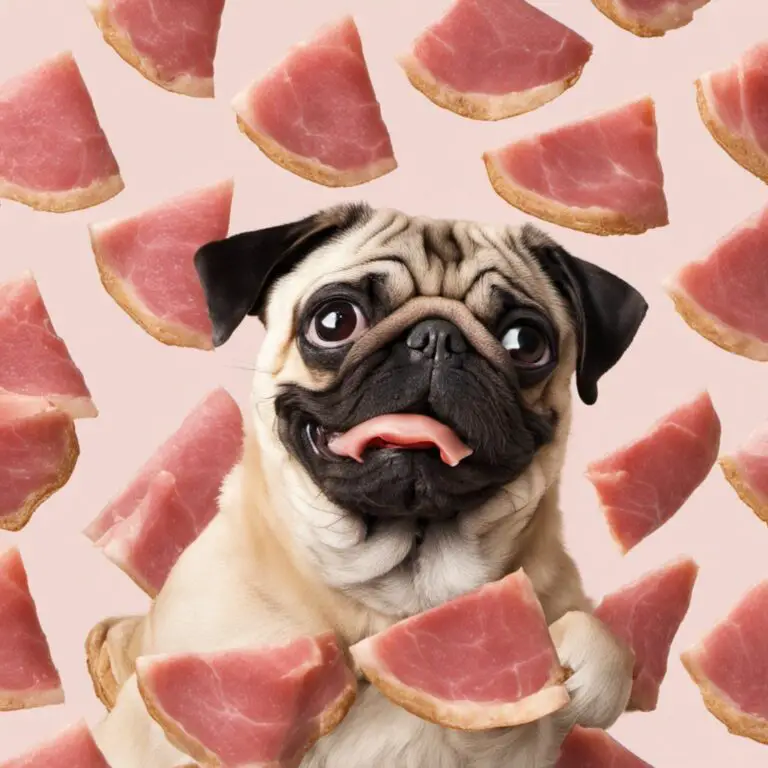Can Pugs Eat Rice? A Comprehensive Guide for Owners
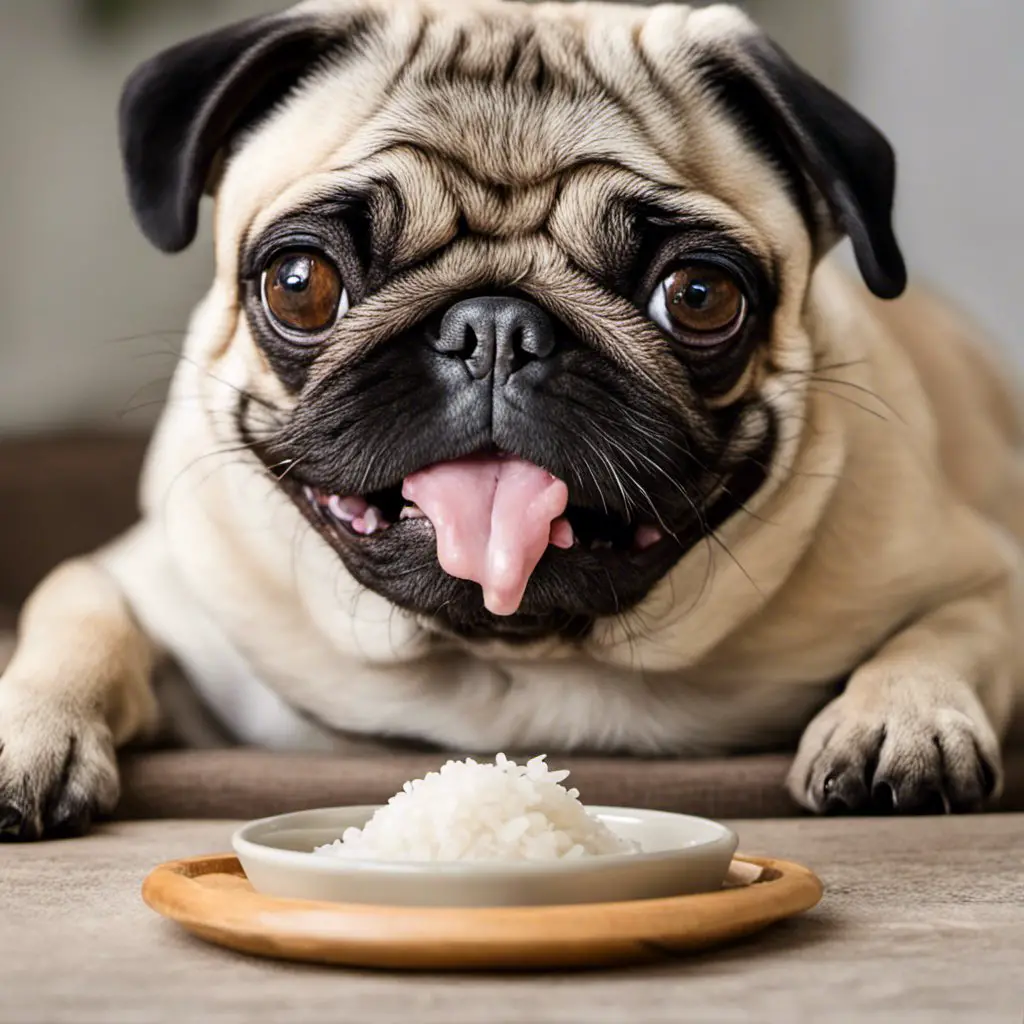
As a pug owner, you may often wonder about the safety of certain foods for your beloved pet. One common question is, Can Pugs Eat Rice? Rice is a staple in many households, offering various nutritional benefits for humans, but is it a good and safe option for your pug?

The good news is that pugs can indeed eat rice. In fact, many commercial dog food recipes include rice as an ingredient. Rice provides a number of essential nutrients that benefit your pug’s health, and it’s a great option for a bland meal when your dog is not feeling well.
When feeding your pug rice, there are a few things to keep in mind. It is important to opt for plain, steamed rice without any seasonings or additives that can be harmful to your furry friend. Additionally, moderation is key, as too much rice can lead to unwanted weight gain or other health issues for your pug.
Contents
Table of Contents
Understanding Pug Diet

As a pug owner, knowing what types of food your furry friend can safely consume is essential. Like all dogs, Pugs require a well-balanced diet, with an ideal mix of proteins, fibers, fats, and calories. When planning your pug’s meals, consider giving them whole grains like rice, as they can serve as a healthy source of energy.
Get The Free Food Eating Guide That Keeps My Pug Happy and Playful Even at 13 Years Old
100% Beginner Friendly & Lists Real Foods Your Pug Can Actually Eat!

Rice can benefit your pug’s diet, as it’s often found in many commercial dog foods. White rice and whole grain rice are suitable options to feed your pug, especially when they’re not feeling well or have chewing difficulties due to old age source. When introducing new food like rice to your pug’s diet, always do so in moderation to avoid potential stomach upsets.
In addition to grains, pugs need a diet rich in proteins. Adult pugs should consume dog food containing 18% crude protein, while puppy food should have around 22% source. Protein ensures your pug maintains its energy levels and supports muscle development. On the other hand, it’s essential to include healthy fats in your pug’s meals, about 5% for adults and 8% for puppies.
When considering treats for your pug, moderation is key, as giving your pet too many treats can lead to obesity and related health issues. Stick to healthy treat options that offer nutritional benefits without excess calories.
Remember, it’s crucial to closely monitor your pug’s overall diet to ensure they maintain a healthy weight and avoid potential health problems. By incorporating different nutrient-rich foods, such as rice, you can provide your pug with a varied and satisfying diet that meets their nutritional needs.
Can Pugs Eat Rice?
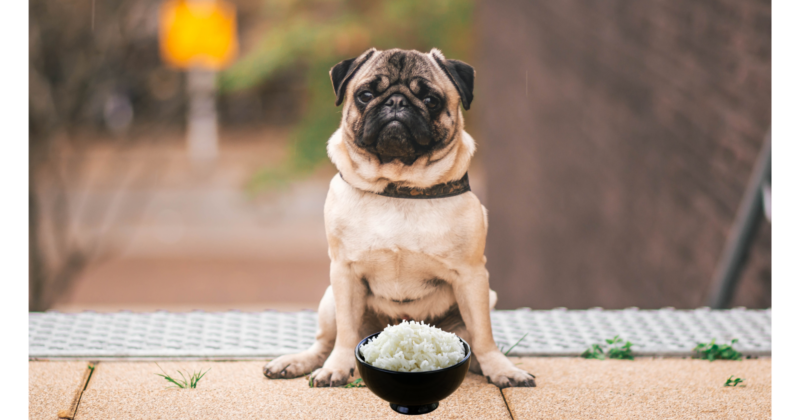
Yes, pugs can eat rice, which is considered a safe and healthy option. Many commercial dog foods include rice as one of their ingredients. Rice provides a source of carbohydrates that can be beneficial for your pug’s energy levels.
When choosing rice for your pug, two main categories are available: white rice and brown rice. White rice is a more refined type of rice, and brown rice is a whole grain option. Both types of rice can be safe for pugs, but it is essential to consult with your veterinarian to determine the best option for your specific dog.
In certain situations, rice can be particularly useful for pugs. For example, when your pug is not feeling well, you can feed them a simple meal of cooked chicken and rice, which is gentle on their stomach. Additionally, rice can be beneficial for older pugs who may have difficulty chewing harder foods.
When feeding rice to your pug, it is essential to ensure that it is cooked properly and free of any spices or additives that may be harmful to them. Plain, cooked rice is the best option in this case. You should also make sure to portion the rice appropriately as a part of a balanced diet, taking into account your pug’s age, weight, and activity level. If you are unsure of the proper portions, it is always best to consult with your veterinarian.
In summary, rice can be a healthy and safe addition to your pug’s diet, providing carbohydrates and energy. White and brown rice are options for your pug, but it is crucial to consult your vet to determine the best choice for your dog. Always ensure the rice is plain, cooked, and portioned appropriately for your pug’s needs.
Rice Vs. Commercial Dog Food

When considering whether to feed your pug rice or commercial dog food, it’s essential to compare both options’ nutritional value and benefits. Rice can be a suitable addition to your pug’s diet, but it should not replace commercial dog food entirely.
Commercial dog food, which includes dry and wet options, is specifically formulated to provide a balanced diet for dogs, containing the necessary nutrients, minerals, and vitamins. These elements may include protein, fiber, fatty acids, and essential vitamins and minerals that contribute to your dog’s overall health. On the other hand, while rice is included in many commercial dog foods, it mainly serves as a carbohydrate source and is not nutritionally complete on its own.
There are two main types of rice: white rice and whole grain rice. White rice is more commonly recommended for pugs due to its easier digestibility. It can be particularly helpful for dogs with gastrointestinal issues, like an upset stomach or diarrhea. However, ensuring your pug still receives other nutrients in their diet is crucial, as rice alone does not offer all the necessary elements for a balanced meal.
When comparing rice to commercial dog food, keep in mind the differences in the sources of protein, minerals, and vitamins:
- Protein: Commercial dog foods typically contain a higher protein content from various animal sources, while rice is a lower protein option.
- Minerals: Dog foods often include additional minerals, such as calcium and phosphorus, whereas rice offers only a handful of minerals in comparison.
- Vitamins: Commercial dog foods are formulated with a variety of vitamins to meet your dog’s needs, while rice, especially white rice, offers fewer vitamins.
In conclusion, while rice can be a valuable addition to your pug’s diet, it should not be the primary food source. Commercial dog food offers a more balanced and complete nutrient set that keeps your pug healthy and thriving. As always, consult with your veterinarian when making dietary changes for your pug to ensure their nutritional needs are met.
The TRUTH about RICE Good or BAD For Dogs? Can pugs eat rice? Watch this
Why Serve Rice to Pugs
Rice can be a beneficial addition to your Pug’s diet for several reasons. It is easily digestible and can help soothe any digestive problems or diarrhea your Pug may experience. Additionally, rice is a good source of fiber, which can aid in maintaining a healthy bowel movement.
Serving rice to your Pug can also enhance their coat’s health and appearance. The natural oils present in rice can contribute to a shinier and healthier coat, giving your Pug that extra glow.
White and brown rice have different benefits, so it’s essential to consider which one is more suitable for your Pug. White rice is easier to digest and cooks faster, making it a better option for Pugs with sensitive stomachs. Meanwhile, brown rice contains more natural nutrients and fiber, which can be beneficial for a Pug’s overall health. However, brown rice has a chewier texture that can be challenging for some Pugs, especially those with dental issues.
When serving rice to your Pug, it’s crucial to cook it thoroughly without any added seasonings, salt, or oil. These ingredients can be harmful to your Pug’s health and should be avoided. It’s also important to remember that rice should be served in moderation and not as a primary food source, as Pugs still require proteins, vitamins, and minerals found in meat and other pet foods.
In summary, incorporating rice into your Pug’s diet can provide several health benefits, including improved digestion, increased fiber intake, and a shinier coat. Just remember to choose the right type of rice and serve it in moderation without any harmful additives.
Proper Serving of Rice for Pugs
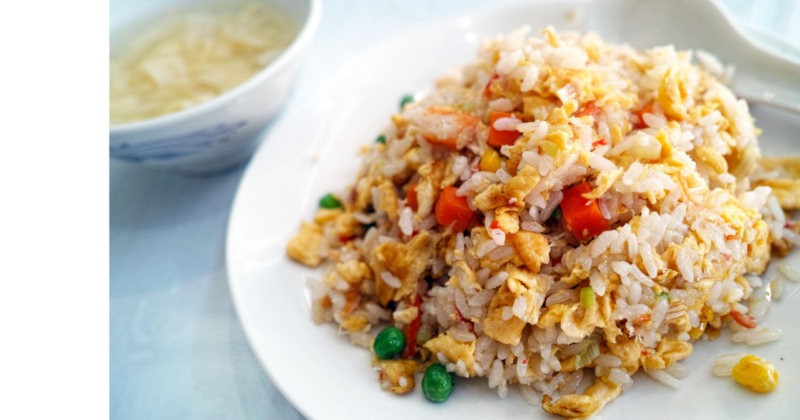
Feeding your pug rice can be a great way to provide them with a healthy source of energy. Rice is easily digestible and can help soothe your dog’s upset tummy issues source. But how much rice should you serve to your pug?
How much to serve: You should serve rice in moderation as part of your pug’s balanced diet. A good starting point is to add one tablespoon of cooked rice per meal and see how your pug reacts to it. Adjust the amount as needed based on your pug’s size, age, activity level, and any special dietary requirements.
Preparation: When preparing rice for your pug, always cook it thoroughly to ensure it is easy to digest. Both white and brown rice are safe for pugs to eat, but white rice is less likely to cause digestive issues source. You should avoid using any spices or additives when cooking rice for your pug as they may contain ingredients that are harmful to dogs.
Mixing with other foods: To make rice more appealing and nutritious for your pug, you can mix it with their regular dog food. Alternatively, you can also incorporate it into a homemade meal by combining it with other dog-friendly ingredients, such as lean proteins and dog-safe vegetables. This helps ensure your pug receives a well-rounded diet.
Remember, moderation is key when introducing rice or any new food to your pug’s diet. Keep a close eye on your pug’s reaction to rice and adjust the serving size as needed. If you notice any adverse reactions or have concerns about rice consumption, consult your veterinarian for guidance.
Comparing Rice with Other Human Foods
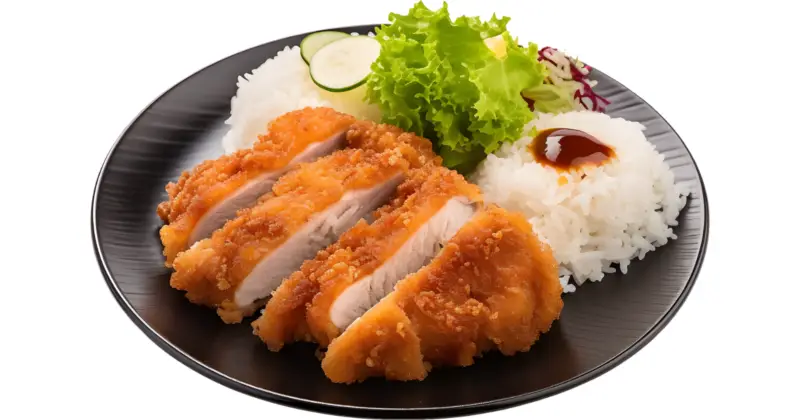
When considering rice as a food option for your pug, it’s important to compare it with other human foods that can be fed to dogs. Rice is a good source of carbohydrates and is easily digestible, making it a suitable choice for pugs with upset tummies. Let’s see how it stacks up against other human foods.
Meat and fish like turkey, salmon, and other lean meats are excellent sources of protein for your pug. They help build strong muscles and provide essential amino acids. However, make sure to cook the meat and fish thoroughly and avoid giving them any bones to prevent choking hazards.
Vegetables such as sweet potatoes, carrots, and broccoli can be a great addition to your pug’s diet. These veggies are packed with vitamins, minerals, and fiber. Just make sure to cook them thoroughly and cut them into small, manageable pieces for your pug to avoid choking.
Fruits like apples, berries, and strawberries can be a healthy treat for your pug. They are rich in antioxidants and vitamins but should be given in moderation due to their sugar content. Avoid fruits like avocado, tomatoes, and green tomatoes, as these can be toxic for your pug.
Eggs are a good protein, calcium, and other essential nutrients source. You can offer your pug cooked eggs, but avoid raw eggs, as they can carry a risk of salmonella infection.
When it comes to grains, rice stands out due to its easy digestion and lack of sodium or fats. It also contains Vitamin E, calcium, iron, and other nutrients. However, be cautious with other grains like garlic and onions, which are toxic to dogs.
Snacks for your pug should be chosen carefully. Plain, low-fat cheese can be a good option, while high-sugar or high-fat snacks should be avoided. Also, avoid giving your pug human snacks containing ingredients like chocolate, caffeine, or xylitol, as these can be harmful to their health.
In summary, rice can be a beneficial addition to your pug’s diet, especially when compared to other human foods. Just remember to always consult with your veterinarian before making any changes to your pet’s diet, and ensure that you are providing them with a balanced and nutritious meal plan.
Common Concerns and Dangers

When feeding your pug rice, it’s essential to be aware of the possible dangers and concerns linked to specific types of food. Understanding these risks will help you provide your pug a safe and healthy diet.
Toxic and poisonous foods can cause harm to your pug, leading to symptoms such as vomiting, seizures, and abdominal pain. Some of the known toxic foods for dogs include grapes, cherries, and avocados. Similarly, Allium family members – onions, garlic, leeks, and chives – can also be dangerous to pugs as they can lead to anemia and gastrointestinal irritation source.
While rice and other grains do not pose severe dangers, allergens can still affect some dogs, causing an upset stomach or other mild symptoms. Keeping an eye out for any unusual reactions can be beneficial in this case.
Blueberries and other fruits can be helpful additions to your pug’s diet. However, they should be consumed in moderation to avoid excessive sugar and calorie intake. Portion control is vital for preventing weight gain and obesity, as pugs are more prone to such health issues source.
Processed foods and snacks with high salt content should be avoided as they contribute to dehydration and aggravate pugs’ breathing issues. Feeding your pug raw potatoes can also be harmful due to the concentration of solanine, a toxic compound that can lead to gastrointestinal issues and weakness.
Caffeine and products containing it are especially dangerous for pugs, as they can cause rapid heart rate, tremors, and seizures. Furthermore, macadamia nuts should never be fed to your pug, as they can lead to weakness, vomiting, and tremors source.
While rice is a generally safe food for pugs, avoiding the risks associated with other ingredients and potential allergens is crucial. By providing your pug with a balanced diet and keeping an eye out for any adverse reactions, you contribute to your dog’s overall well-being.
Managing Pug’s Weight

Maintaining a healthy weight for your pug is essential to prevent obesity-related health issues. Feeding the right type of food and monitoring portion sizes are crucial in regulating their weight.
One way to manage your pug’s weight is by incorporating rice into their diet. Rice is a good source of carbohydrates and is easily digestible, which can help fuel your dog’s body with energy and soothe their upset tummy issues source. Choosing the right type of dog food is also important. For instance, the Royal Canin Breed Health Nutrition Pug Dry Dog Food is designed specifically for the nutritional needs of purebred pugs aged 10 months and up source.
If your pug is overweight, you might consider switching to weight-control dog food, such as Purina Pro Plan High Protein Weight Control Dry Dog Food for pugs. This food contains real chicken as the first ingredient and has 26% protein to help energize your pup and keep them fit source.
It’s helpful to store their food in fixed portions to ensure that you do not overfeed your pug. If your pug is on a raw diet, you can calculate 2% of their ideal weight and feed them this set amount source.
In addition to providing the right food, remember to include regular exercise for your pug. Pugs may not require as much exercise as some other breeds, but incorporating daily walks or playtime will help maintain their overall health and prevent weight gain.
By keeping a close eye on your pug’s diet and exercise routine, you can effectively manage their weight and ensure they stay within an ideal range, avoiding issues related to obesity and promoting a healthier, happier life for your furry companion.
Consulting Vet for Diet Changes

Before making any significant changes to your pug’s diet, it’s essential to consult with your veterinarian. They possess the knowledge and experience required to guide you in making the best decisions for your pug’s nutritional well-being.
Dogs, including pugs, can safely eat rice. In fact, rice is an ingredient often found in many commercial dog foods and can be beneficial for dogs with gastrointestinal issues1. However, it’s important to maintain a balanced diet for your pug, and your veterinarian can help identify any nutritional gaps or potential health concerns.
When discussing diet changes with your vet, they may ask about your pug’s eating habits, allergies, and overall health history. This information is key to determining the best approach for incorporating rice into your pug’s diet.
If your pug experiences digestion problems or has a sensitive stomach, rice may be used as a bland alternative to more complex carbohydrates2. Your veterinarian can provide guidance regarding portion sizes, frequency, and other necessary adjustments.
Remember that any dietary changes should be introduced gradually to avoid sudden disruptions to your pug’s digestive system. Consult with your veterinarian regularly to monitor your pug’s well-being and adapt the dietary plan accordingly.
Frequently Asked Questions: Can Pugs Eat Rice
Can cooked rice be given to pugs?
Yes, cooked rice can be given to pugs as a part of their diet. Brown rice is a better option, as it is higher in protein and has less fat than white rice. It also contains the outer layers of the hull, making it more fibrous and beneficial for digestion.
Is chicken and rice safe for pugs?
Chicken and rice is a safe and nutritious option for pugs. Make sure you cook the chicken thoroughly and remove any bones to prevent choking or injury. Mixing cooked rice into the chicken provides a good source of carbohydrates and added nutrients for your pug.
Can pugs consume rice with eggs?
Combining cooked rice with eggs is another meal option for pugs. Ensure that the eggs are fully cooked, as raw eggs can pose a risk for salmonella. This mix provides your pug with protein, carbohydrates, and essential amino acids for a balanced and nutritious meal.
How often should dogs be fed rice?
Rice can be fed in moderation to dogs, making up no more than 10 percent of your pug’s daily caloric consumption. Overfeeding rice can lead to extra calories and weight gain. It is important to maintain a well-balanced diet that incorporates other vital nutrients for your pug’s overall health.
What are the benefits of rice for pugs?
Rice provides dogs, including pugs, with carbohydrates for energy and digestion-enhancing fiber. When combined with a source of protein like chicken, it can help maintain healthy skin, coat, teeth, and support a strong immune system in your pug. Brown rice, in particular, offers higher protein content and less fat than white rice.
Are there any risks for pugs eating rice?
As long as pugs eat rice in moderation and as part of a balanced diet, there are minimal risks associated with feeding them rice. Overfeeding rice or relying solely on it as a food source can lead to weight gain, nutrient deficiencies, and potential digestive issues. Always ensure that rice is properly cooked and free of any added ingredients that may be harmful to pugs.




